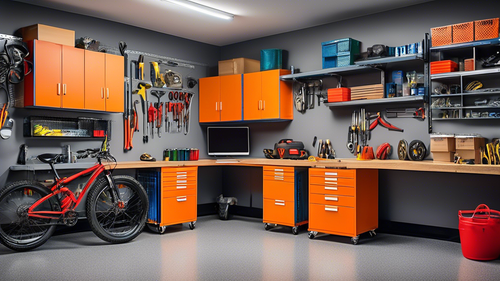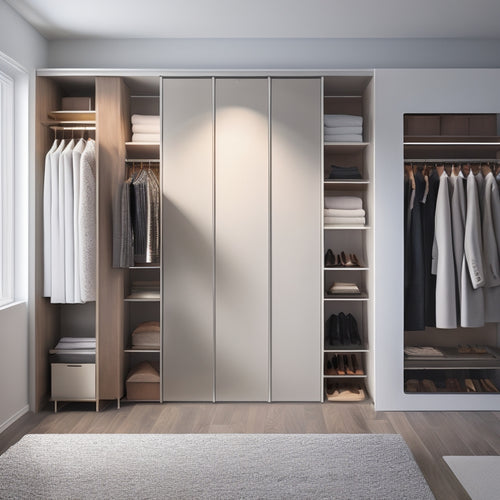
Build Your Own Pantry Storage Shelves
Share
You'll need to assess your pantry's unique dimensions and storage requirements before building custom shelves that efficiently hold your food and cooking essentials. Measure your pantry's width, depth, and height to determine the perfect shelf size, and identify the types and quantities of items you need to store. Adopt regular organization habits and group similar items together to maximize shelf space. With a clear plan, you can choose the right materials and tools, design a functional layout, and build sturdy shelves that fit your needs. Now, get ready to create a pantry that's both functional and stylish, one shelf at a time.
Key Takeaways
- Measure pantry dimensions to determine shelf size and ensure a snug fit for optimal storage and accessibility.
- Choose the right materials, such as oak or plywood, and essential tools, like a circular saw and drill, for a sturdy build.
- Design a shelf layout that allocates space based on item sizes and access frequency, optimizing storage capacity and efficiency.
- Build shelf frames using sturdy materials, prioritizing stability and load capacity, and distribute weight evenly to prevent sagging.
- Install shelves at ideal heights, ensuring even spacing and secure attachment, and finalize with a functional and organized pantry setup.
Assessing Pantry Space and Needs
Take stock of your pantry space by measuring its dimensions, including the width, depth, and height of the area where you plan to install the shelves. This will assist you in determining the maximum size of your shelves and guarantee a snug fit.
Next, consider the types and quantities of items you need to store. Think about the pantry organization tips that matter most to you, such as easy access to frequently used items or maximizing storage for bulk purchases.
To maintain organization, adopt a habit of regularly revisiting and tidying key areas like your pantry. Make a list of the items you want to store and group them by category, like baking supplies or canned goods. This will help you visualize how you can optimize your shelves for efficient storage and retrieval.
Choosing Materials and Tools
With your pantry space assessed and your storage needs identified, you're ready to select the materials and tools necessary for building your pantry storage shelves. You'll need to decide on the type of wood, tool selection, and shelf style that fits your budget and meets your storage needs.
| Wood Types | Tool Selection | Shelf Styles |
|---|---|---|
| Oak, Maple, or Cherry | Circular saw, drill, and sander | Adjustable, fixed, or slanted shelves |
| Plywood or MDF | Tape measure, level, and clamps | Open, closed, or combination shelves |
| Cedar or Pine | Safety glasses, ear protection, and a workbench | Simple, decorative, or custom shelves |
Remember to take into account weight limits, maintenance tips, and budget considerations when making your selections. By choosing the right materials and tools, you'll be able to build pantry storage shelves that meet your specific needs and fit your style.
Designing Your Shelf Layout
You'll start designing your shelf layout by planning the space you need for your pantry items, considering the items you want to store and how often you'll access them.
Next, take precise measurements of your pantry, including the width, depth, and any obstacles like windows or plumbing.
Then, optimize your shelf height by grouping similar items together and reserving the most accessible shelves for your most frequently used items.
Shelf Space Planning
Before constructing your pantry storage shelves, mapping out the shelf space is crucial to maximize storage capacity and efficiency.
You'll want to take into account the types of items you'll be storing, their sizes, and how frequently you'll access them. This will help you determine the ideal shelf organization and storage solutions for your pantry.
Think about grouping similar items together, such as canned goods, baking supplies, and snacks. Reflect on the height and depth of your shelves, as well as the space between them, to guarantee easy access and visibility.
By carefully planning your shelf space, you'll be able to create a functional and efficient pantry that meets your specific needs.
With a clear plan in place, you'll be ready to start building your pantry storage shelves.
Measure Your Pantry
Measure your pantry's dimensions to create a customized shelf layout. Take precise measurements of the width, depth, and height of your pantry, including any obstructions like plumbing or electrical outlets. Record these measurements to refer to later.
Consider the door and window locations, as well as any fixed shelves or appliances that will impact your storage organization. Identify the areas where you need the most storage, such as corner spaces or areas near frequently used items.
With these pantry dimensions, you'll be able to design a shelf layout that maximizes your storage space and streamlines your storage organization.
Optimize Shelf Height
With your pantry's dimensions in hand, it's time to translate them into a functional shelf layout that optimizes storage space.
When designing your shelf layout, consider the shelf height. You'll want to maximize vertical storage while keeping frequently used items within easy reach. Aim for shelf heights between 12 and 18 inches, depending on the items you plan to store.
For added flexibility, consider installing adjustable shelves that can be easily reconfigured as your storage needs change. This will allow you to customize your shelf layout to fit your unique storage requirements.
Building the Shelf Frames
You'll start building your pantry storage shelves by designing the shelf frames, which involves deciding on the type of frame and its dimensions.
For a sturdy frame, you'll want to use 3/4-inch plywood or MDF, and consider a rectangular frame with a flat top and bottom.
Next, you'll move on to assembling the frames, following steps that include cutting the frame pieces, sanding the cut edges, and attaching the sides and back.
Shelf Frame Design
The shelf frame design is the backbone of your pantry storage shelves, providing a sturdy structure to hold your precious storage bins and baskets.
You'll want to prioritize shelf stability and load capacity to guarantee your shelves can support the weight of your stored items.
Consider the aesthetics of your shelf frame design, choosing frame materials that complement your pantry's style.
Opt for design flexibility to accommodate varying shelf sizes and customization options.
By employing DIY techniques, you can create a customized solution that meets your specific needs.
Remember to distribute weight evenly across each shelf to prevent bowing or sagging.
With careful planning, your shelf frame design will provide a solid foundation for your pantry storage shelves.
Frame Assembly Steps
Precision is key as you commence on the frame assembly steps, where every cut, drill, and screw counts in building sturdy shelf frames.
Begin by gathering your frame materials, ensuring all pieces are accurately cut to size. Next, assemble the frame's vertical components, using screws to secure them to the top and bottom plates.
Make sure the corners are square and the frame stability is maintained throughout the process. Use clamps to hold the pieces in place while you screw them together.
As you work, double-check your measurements to avoid errors. With each piece precisely aligned, your shelf frames will be rock-solid and ready for the next step.
Adding Shelf Boards and Backs
Cutting the shelf boards to size, assemble them onto the shelf frames, guaranteeing they fit snugly between the vertical dividers.
You have various shelf board options, including solid wood, engineered wood, or medium-density fiberboard (MDF). Choose a material that suits your pantry's style and budget.
Next, attach the shelf boards to the frames using screws or nails, making certain they're evenly spaced and secure.
For the backs of your shelves, select suitable backing materials like plywood, MDF, or pegboard. Cut them to fit the shelf frames, and attach them using screws or nails.
This will provide a flat surface for storing items and add stability to your shelves. Ascertain the backing materials are securely attached to prevent them from sagging or falling off.
Installing the Pantry Shelves
With your shelf boards and backs securely in place, you're ready to install the pantry shelves.
To begin, determine the ideal shelf height for your pantry items, considering the sizes of your containers and the frequency of use. Use shelf installation techniques, such as measuring and marking the wall studs, to guarantee a sturdy and level installation.
Install the shelves, making sure they're evenly spaced and securely attached to the wall. As you install each shelf, consider pantry organization tips, like grouping similar items together and placing heavy items at the bottom.
Adding Finishing Touches
Now that your pantry shelves are installed, it's time to add the finishing touches that will make your pantry both functional and visually appealing.
Start by incorporating decorative accents, such as wicker baskets or ceramic containers, to add a personal touch. Organizational bins and labeling systems will help keep your pantry organized and easy to manage.
Choose a color scheme that complements your kitchen's aesthetic and consider adding lighting options, like under-shelf lighting, to highlight your pantry's contents.
Install shelf dividers to separate items and prevent clutter.
Frequently Asked Questions
Can I Use MDF Instead of Plywood for the Shelf Boards?
You can use MDF instead of plywood for shelf boards, but weigh MDF's advantages (density, affordability, and ease of cutting) against its disadvantages (moisture sensitivity, heavier weight, and potential for sagging) to make certain it's the right choice for your project.
How Do I Prevent the Shelves From Sagging Over Time?
To prevent sagging, you'll guarantee proper shelf support by installing vertical dividers or brackets, which will promote even weight distribution and keep your shelves level, maintaining their structural integrity over time.
Are Adjustable Shelves Necessary for Optimal Pantry Storage?
When optimizing pantry storage, you'll want to contemplate adjustable shelving, which offers benefits like flexibility and maximizing space. By incorporating adjustable shelves, you're ensuring easy rearrangement to accommodate changing storage needs, ultimately enhancing your pantry's overall functionality.
Can I Add a Sliding Basket or Drawer to My Pantry Shelves?
You cleverly consider cunning closet components: can you create convenient, customizable storage by adding a sliding basket or drawer to your shelves, leveraging clever sliding mechanisms and carefully choosing basket sizes to maximize space?
Do I Need to Add a Back Panel to the Pantry Shelves?
You're wondering if a back panel is necessary - it's optional, but it provides benefits like added stability and a finished look. If you decide to install one, make certain it's flush with the shelves and securely attached to the wall for maximum support.
Related Posts
-

Garage Storage: A Boost to Your Home Value
Making the Most of a Hidden Gem Are you looking to increase your home's value without breaking the bank? Garage st...
-

Declutter Your Closet With Digital Essentials
You're about to transform your closet from a cluttered chaos to a curated sanctuary with the power of digital essenti...
-

What Makes a Perfect Laundry Room Layout?
You're designing a laundry room that's a haven of efficiency and style, where every element works in harmony to make ...


